实验六 接口的定义与使用
实验时间 2018-10-18
1、实验目的与要求
(1) 掌握接口定义方法;
声明: public interface 接口名
{...}
接口体中包含常量定义和方法定义,接口中只进行方法的声明,不提供方法的实现。
在类声明时用implements声明使用一个或多个接口
Class Employee implements Printable
{...}
一个类使用了某个接口,那么这个类必须实现该接口的所有方法。即为这些方法提供方法体。
(2) 掌握实现接口类的定义要求;
通常接口的名字以able或ible结尾。
可以使用extends来继承接口的常量和抽象方法,扩展形成新的接口。
public interface 接口1 extends 接口2
{...}
接口中的所有常量必须是public static final ,方法必须是public abstract,这是系统默认的,不管在定义接口时,写不写修饰符都是一样的。
(3) 掌握实现了接口类的使用要求;
接口不能构造接口对象,但可以声明接口变量。
Comparable x = new Comparable(...);//error
Comparable x = new Employee(...);//right
可以使用instanceof检查对象是否实现了某个接口。
if(anobject instanceof Comparable)
{...}
(4) 掌握程序回调设计模式;
回调:一种程序设计模式,在这种模式中,可指出某个事件发生时程序应该采取的动作。
在java.Swing包中,有一个Timer类,可以使用它,在到达给定时间间隔时触发一个事件。
Timer (interval ActionListener listener)
Void start()
Void stop()
(5) 掌握Comparator接口用法;
所在包 java.util.*
定义 public interface Comparator<T>{
Int compare(T 01,T 02);
......
}
用途:处理字符串按长度进行排序的操作。
(6) 掌握对象浅层拷贝与深层拷贝方法;
浅层拷贝:被拷贝对象的所有常量成员和基本类型属性都有与原来对象相同的拷贝值,而若成员域是一个对象,则被拷贝对象该对象域的对象引用仍然只像原来的对象。
深层拷贝:被拷贝对象的所有成员域都含有与原来对象相同的值,且对象域将指向被复制过的新对象,而不是原有对象被引用的对象,换言之,深层拷贝将拷贝对象内引用的对象也拷贝一遍。
(7) 掌握Lambda表达式语法;
(arguments)->body
(8) 了解内部类的用途及语法要求。
[修饰符]class outerClass{
...
[修饰符]class innerClass{
...
}
2、实验内容和步骤
实验1: 导入第6章示例程序,测试程序并进行代码注释。
测试程序1:
l 编辑、编译、调试运行阅读教材214页-215页程序6-1、6-2,理解程序并分析程序运行结果;
l 在程序中相关代码处添加新知识的注释。
l 掌握接口的实现用法;
l 掌握内置接口Compareable的用法。
package interfaces; public class Employee implements Comparable<Employee> //Employee实现内置接口Comparable { private String name; private double salary; public Employee(String name, double salary)//构造方法 { this.name = name; this.salary = salary; } public String getName()//name属性的类方法 { return name; } public double getSalary() { return salary; } //调用raiseSalary方法 public void raiseSalary(double byPercent)//改写工资数据的类方法 { double raise = salary * byPercent / 100; salary += raise; } /** * Compares employees by salary * @param other another Employee object * @return a negative value if this employee has a lower salary than * otherObject, 0 if the salaries are the same, a positive value otherwise */ public int compareTo(Employee other)//CompareTo方法 一个参数 { return Double.compare(salary, other.salary); } }
package interfaces; import java.util.*; /** * This program demonstrates the use of the Comparable interface. * @version 1.30 2004-02-27 * @author Cay Horstmann */ public class EmployeeSortTest { public static void main(String[] args) { Employee[] staff = new Employee[3];//定义普通数组 staff[0] = new Employee("Harry Hacker", 35000); staff[1] = new Employee("Carl Cracker", 75000); staff[2] = new Employee("Tony Tester", 38000); Arrays.sort(staff);//Arrays类的sort方法 静态方法的特权:通过类名调用 对数组进行排序 // print out information about all Employee objects for (Employee e : staff) System.out.println("name=" + e.getName() + ",salary=" + e.getSalary()); } }
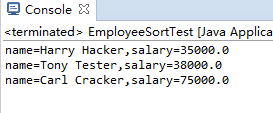
测试程序2:
l 编辑、编译、调试以下程序,结合程序运行结果理解程序;
package 小陈13; public class InterfaceTest { public static void main(String[ ] args) { A a=new C( ); a.show( ); System.out.println("g="+C.g); } }
package 小陈13; public interface A { double g = 9.8; void show(); }
package 小陈13; class C implements A { public void show( ) {System.out.println("g="+g);} }
输出结果:

测试程序3:
l 在elipse IDE中调试运行教材223页6-3,结合程序运行结果理解程序;
l 26行、36行代码参阅224页,详细内容涉及教材12章。
l 在程序中相关代码处添加新知识的注释。
l 掌握回调程序设计模式;
package timer; /** @version 1.01 2015-05-12 @author Cay Horstmann */ import java.awt.*; import java.awt.event.*; import java.util.*; import javax.swing.*; import javax.swing.Timer; // to resolve conflict with java.util.Timer public class TimerTest { public static void main(String[] args) { ActionListener listener = new TimePrinter(); //实现了ActionListener的类对象,并将它传递给Timer构造器。 // construct a timer that calls the listener // once every 10 seconds Timer t = new Timer(10000, listener); t.start();//启动定时器 JOptionPane.showMessageDialog(null, "Quit program?"); System.exit(0); } } //实现了java。awt。event包中的ActionListener接口,当到达指定的时间时,定时器就调用actionPerformed方法 class TimePrinter implements ActionListener//定义一个实现ActionListener接口的类 { public void actionPerformed(ActionEvent event) { System.out.println("At the tone, the time is " + new Date()); Toolkit.getDefaultToolkit().beep(); } }
输出结果:每显示一次 At the Tone,.... 信息,然后响铃一声,按确定键终止。
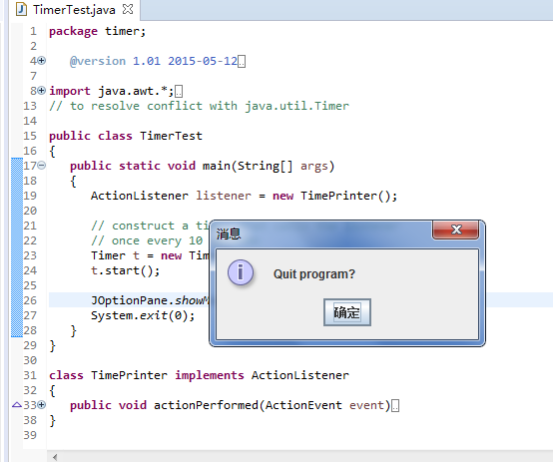

测试程序4:
l 调试运行教材229页-231页程序6-4、6-5,结合程序运行结果理解程序;
l 在程序中相关代码处添加新知识的注释。
l 掌握对象克隆实现技术;
l 掌握浅拷贝和深拷贝的差别。
package clone; import java.util.Date; import java.util.GregorianCalendar; public class Employee implements Cloneable { private String name; private double salary; private Date hireDay; public Employee(String name, double salary) { this.name = name; this.salary = salary; hireDay = new Date(); } public Employee clone() throws CloneNotSupportedException { // call Object.clone() Employee cloned = (Employee) super.clone(); // clone mutable fields cloned.hireDay = (Date) hireDay.clone(); return cloned; } /** * Set the hire day to a given date. * @param year the year of the hire day * @param month the month of the hire day * @param day the day of the hire day */ public void setHireDay(int year, int month, int day) { Date newHireDay = new GregorianCalendar(year, month - 1, day).getTime(); // Example of instance field mutation hireDay.setTime(newHireDay.getTime()); } public void raiseSalary(double byPercent) { double raise = salary * byPercent / 100; salary += raise; } public String toString() { return "Employee[name=" + name + ",salary=" + salary + ",hireDay=" + hireDay + "]"; } }
package clone; /** * This program demonstrates cloning. * @version 1.10 2002-07-01 * @author Cay Horstmann */ public class CloneTest { public static void main(String[] args) { try//异常处理技术 { Employee original = new Employee("John Q. Public", 50000); original.setHireDay(2000, 1, 1); Employee copy = original.clone(); copy.raiseSalary(10);//原有对象不会发生变化 copy.setHireDay(2002, 12, 31);//调用更改器 System.out.println("original=" + original);//字符串连接 System.out.println("copy=" + copy); } catch (CloneNotSupportedException e)//接收异常 { e.printStackTrace();//打印异常信息 } } }
输出结果:

实验2: 导入第6章示例程序6-6,学习Lambda表达式用法。
l 调试运行教材233页-234页程序6-6,结合程序运行结果理解程序;
l 在程序中相关代码处添加新知识的注释。
l 将27-29行代码与教材223页程序对比,将27-29行代码与此程序对比,体会Lambda表达式的优点。
package lambda; import java.util.*; import javax.swing.*; import javax.swing.Timer; /** * This program demonstrates the use of lambda expressions. * @version 1.0 2015-05-12 * @author Cay Horstmann */ public class LambdaTest { public static void main(String[] args) { String[] planets = new String[] { "Mercury", "Venus", "Earth", "Mars", "Jupiter", "Saturn", "Uranus", "Neptune" };//定义数组planets System.out.println(Arrays.toString(planets));//静态方法 ,可以通过类名调用。调用Arrays的toString方法 System.out.println("Sorted in dictionary order:"); Arrays.sort(planets); System.out.println(Arrays.toString(planets)); System.out.println("Sorted by length:"); //比较器 Arrays.sort(planets, (first, second) -> first.length() - second.length()); //Lambda表达式 : 参数 ,箭头(->)表达式 System.out.println(Arrays.toString(planets)); //动作监听器 Timer t = new Timer(1000, event -> System.out.println("The time is " + new Date()));//Lambda表达式 t.start(); // keep program running until user selects "Ok" JOptionPane.showMessageDialog(null, "Quit program?"); System.exit(0); } }
输出结果:
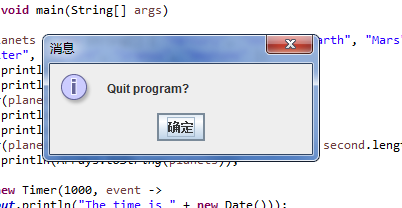
控制台输出

实验3: 编程练习
l 编制一个程序,将身份证号.txt 中的信息读入到内存中;
l 按姓名字典序输出人员信息;
l 查询最大年龄的人员信息;
l 查询最小年龄人员信息;
l 输入你的年龄,查询身份证号.txt中年龄与你最近人的姓名、身份证号、年龄、性别和出生地;
l 查询人员中是否有你的同乡。
Identity
package 小陈9;
import java.io.BufferedReader;
import java.io.File;
import java.io.FileInputStream;
import java.io.FileNotFoundException;
import java.io.IOException;
import java.io.InputStreamReader;
import java.util.ArrayList;
import java.util.Arrays;
import java.util.Collections;
import java.util.Scanner;
public class Identity{
private static ArrayList<Student> studentlist;
public static void main(String[] args) {
studentlist = new ArrayList<>();
Scanner scanner = new Scanner(System.in);
File file = new File("C:/身份证号.txt");
try {
FileInputStream fis = new FileInputStream(file);
BufferedReader in = new BufferedReader(new InputStreamReader(fis));
String temp = null;
while ((temp = in.readLine()) != null) {
Scanner linescanner = new Scanner(temp);
linescanner.useDelimiter(" ");
String name = linescanner.next();
String number = linescanner.next();
String sex = linescanner.next();
String age = linescanner.next();
String province =linescanner.nextLine();
Student student = new Student();
student.setName(name);
student.setnumber(number);
student.setsex(sex);
int a = Integer.parseInt(age);
student.setage(a);
student.setprovince(province);
studentlist.add(student);
}
} catch (FileNotFoundException e) {
System.out.println("学生信息文件找不到");
e.printStackTrace();
} catch (IOException e) {
System.out.println("学生信息文件读取错误");
e.printStackTrace();
}
boolean isTrue = true;
while (isTrue) {
System.out.println("选择你的操作,输入正确格式的选项");
System.out.println("1.字典排序");
System.out.println("2.输出年龄最大和年龄最小的人");
System.out.println("3.寻找老乡");
System.out.println("4.寻找年龄相近的人");
System.out.println("0.退出");
int status = scanner.nextInt();
switch (status) {
case 1:
Collections.sort(studentlist);
System.out.println(studentlist.toString());
break;
case 2:
int max=0,min=100;
int j,k1 = 0,k2=0;
for(int i=1;i<studentlist.size();i++)
{
j=studentlist.get(i).getage();
if(j>max)
{
max=j;
k1=i;
}
if(j<min)
{
min=j;
k2=i;
}
}
System.out.println("年龄最大:"+studentlist.get(k1));
System.out.println("年龄最小:"+studentlist.get(k2));
break;
case 3:
System.out.println("老家?");
String find = scanner.next();
String place=find.substring(0,3);
for (int i = 0; i <studentlist.size(); i++)
{
if(studentlist.get(i).getprovince().substring(1,4).equals(place))
System.out.println("老乡"+studentlist.get(i));
}
break;
case 4:
System.out.println("年龄:");
int yourage = scanner.nextInt();
int near=agenear(yourage);
int value=yourage-studentlist.get(near).getage();
System.out.println(""+studentlist.get(near));
break;
case 0:
status = 0;
System.out.println("程序已退出!");
break;
default:
System.out.println("输入错误");
}
}
}
public static int agenear(int age) {
int min=53,value=0,k=0;
for (int i = 0; i < studentlist.size(); i++)
{
value=studentlist.get(i).getage()-age;
if(value<0) value=-value;
if (value<min)
{
min=value;
k=i;
}
}
return k;
}
}
Student
package 小陈9; public class Student implements Comparable<Student> { private String name; private String number ; private String sex ; private int age; private String province; public String getName() { return name; } public void setName(String name) { this.name = name; } public String getnumber() { return number; } public void setnumber(String number) { this.number = number; } public String getsex() { return sex ; } public void setsex(String sex ) { this.sex =sex ; } public int getage() { return age; } public void setage(int age ) { this.age=age ; } public String getprovince() { return province; } public void setprovince(String province) { this.province=province ; } @Override public int compareTo(Student other) { // TODO Auto-generated method stub return this.name.compareTo(other.getName()); } public String toString() { return name+"\t"+sex+"\t"+age+"\t"+number+"\t"+province+"\n"; } }
输出结果
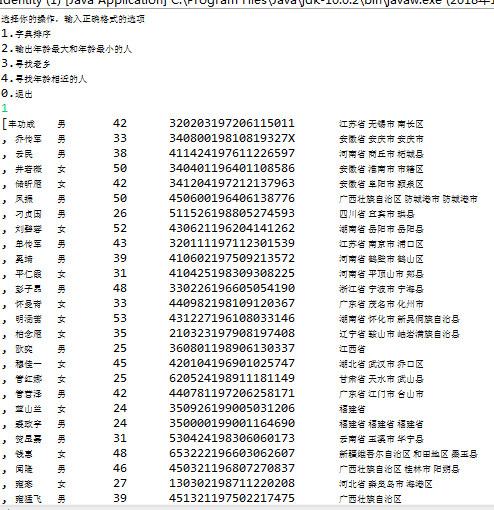
实验4:内部类语法验证实验
实验程序1:
l 编辑、调试运行教材246页-247页程序6-7,结合程序运行结果理解程序;
l 了解内部类的基本用法。
package innerClass; import java.awt.*; import java.awt.event.*; import java.util.*; import javax.swing.*; import javax.swing.Timer; /** * This program demonstrates the use of inner classes. * @version 1.11 2015-05-12 * @author Cay Horstmann */ public class InnerClassTest { public static void main(String[] args) { TalkingClock clock = new TalkingClock(1000, true);//实现了TalkingClock的类对象 clock.start(); // keep program running until user selects "Ok" JOptionPane.showMessageDialog(null, "Quit program?"); System.exit(0); } } /** * A clock that prints the time in regular intervals. */ class TalkingClock//用户自定义类 { private int interval; private boolean beep; /** * Constructs a talking clock * @param interval the interval between messages (in milliseconds) * @param beep true if the clock should beep */ public TalkingClock(int interval, boolean beep) { this.interval = interval; this.beep = beep; }//构造方法 /** * Starts the clock. */ public void start() { ActionListener listener = new TimePrinter();//创建TimePrinter方法,将this引用传递给当前的语音时钟的构造器 Timer t = new Timer(interval, listener); //构造一个语音时钟需要提供两个参数:发布通告的间隔和开关铃声的标志 t.start(); //开始计时 } //TimePrinter类位于TalkClock类内部 public class TimePrinter implements ActionListener { public void actionPerformed(ActionEvent event) { System.out.println("At the tone, the time is " + new Date()); if (beep) Toolkit.getDefaultToolkit().beep();//actionPerformed方法在发出铃声之前检查了beep标志 } } }
输出结果:输出结果:每显示一次 At the Tone,.... 信息,然后响铃一声,按确定键终止。

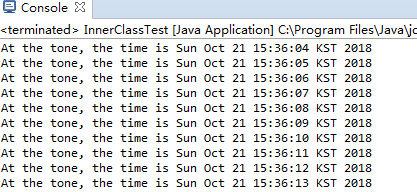
实验程序2:
l 编辑、调试运行教材254页程序6-8,结合程序运行结果理解程序;
l 了解匿名内部类的用法。
package anonymousInnerClass; import java.awt.*; import java.awt.event.*; import java.util.*; import javax.swing.*; import javax.swing.Timer; /** * This program demonstrates anonymous inner classes. * @version 1.11 2015-05-12 * @author Cay Horstmann */ public class AnonymousInnerClassTest { public static void main(String[] args) { TalkingClock clock = new TalkingClock(); clock.start(1000, true); // keep program running until user selects "Ok" JOptionPane.showMessageDialog(null, "Quit program?"); System.exit(0); } } /** * A clock that prints the time in regular intervals. */ class TalkingClock { /** * Starts the clock. * @param interval the interval between messages (in milliseconds) * @param beep true if the clock should beep */ //匿名内部类 public void start(int interval, boolean beep) { ActionListener listener = new ActionListener() { public void actionPerformed(ActionEvent event) { System.out.println("At the tone, the time is " + new Date()); if (beep) Toolkit.getDefaultToolkit().beep(); //外围类引用. } }; Timer t = new Timer(interval, listener); t.start(); } }
输出结果:

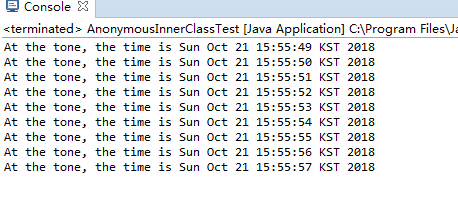
实验程序3:
l 在elipse IDE中调试运行教材257页-258页程序6-9,结合程序运行结果理解程序;
l 了解静态内部类的用法。
package staticInnerClass; /** * This program demonstrates the use of static inner classes. * @version 1.02 2015-05-12 * @author Cay Horstmann */ public class StaticInnerClassTest { public static void main(String[] args) { double[] d = new double[20]; for (int i = 0; i < d.length; i++) d[i] = 100 * Math.random();//算法 ArrayAlg.Pair p = ArrayAlg.minmax(d); System.out.println("min = " + p.getFirst()); System.out.println("max = " + p.getSecond()); }//静态内部类的方法必须返回两个数值 } class ArrayAlg { /** * A pair of floating-point numbers */ public static class Pair//将 Pair 定义为 ArrayAlg 的内部公有类,声明为static { //声明私有属性 private double first; private double second; /** * Constructs a pair from two floating-point numbers * @param f the first number * @param s the second number */ public Pair(double f, double s) //定义包含两个值的类pair { first = f; second = s; } /** * Returns the first number of the pair * @return the first number */ public double getFirst() { return first; } // 访问器 /** * Returns the second number of the pair * @return the second number */ public double getSecond() { return second; } } /** * Computes both the minimum and the maximum of an array * @param values an array of floating-point numbers * @return a pair whose first element is the minimum and whose second element * is the maximum */ //该方法的调用者可以使用 getFirst 和 getSecond 方法获得答案 public static Pair minmax(double[] values) { double min = Double.POSITIVE_INFINITY; double max = Double.NEGATIVE_INFINITY; for (double v : values) { if (min > v) min = v; if (max < v) max = v; } return new Pair(min, max);//返回一个pair类型的对象 } }
输出结果:

实验总结:本单元主要学习了接口的相关知识,了解和熟悉了接口的使用方法,Lambda表达式语法,Comparator接口用法,还能够区分浅拷贝和深拷贝的异同之处,最后基本了解了内部类的定义和使用。主要对内部类,还有深层拷贝以及浅层拷贝方面的知识没有完全理解,还需要继续学习。编程实验是在原来的身份证号文本 按照姓名和按照号码进行查询的基础上改进得到的。